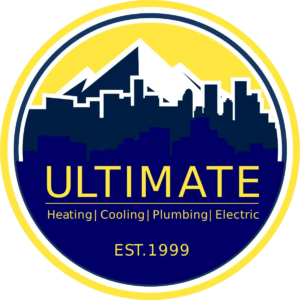We’ve installed and repaired all types of heating and cooling systems during our 40+ years serving the Denver area, ranging from packaged setups to hybrid systems using two or more power sources. However, the most common one we’ve come across is the standard split system, which is also known as central heat and air setup.
Read below to learn more about split systems, why they’re popular, and when to replace your existing setup.
What is a central/standard split system HVAC?
A standard split system uses two separate units for cooling and heating. Typically, the cooling unit is installed outdoors and the heating unit is in the basement. Refrigerant is used for the cooling process and, in most cases, fossil fuel is used to generate heat. Thermostats are used to control the temperature, and the air is distributed around the home using ducts, fans, and blower motors.
There are several types of HVAC systems installed in Denver homes. Here’s how they compare to the standard split system:
Ductless mini-splits
Ductless mini-splits provide heating and cooling. Outside is a compressor unit and condensing coil, and inside is a wall or ceiling-mounted air-handler and evaporator coil. There is no separate heating unit unless it’s part of a hybrid setup.
Evaporative cooling systems
Evaporative cooling systems do not provide any heating and use evaporated water to cool the air. There are portable, free-standing versions, as well as larger roof-mounted models.
Heat pumps
Heat pumps use refrigerant to draw thermal energy from one of three sources: water, air, or geothermal. They provide heating and cooling using an outdoor compressor unit, along with indoor components unique to heat pumps: a reversing valve, suction line accumulator, and crank-case heater.
Window or wall-mounted air-conditioners
Window or wall-mounted air-conditioners have all the components in a single compact unit.
Wondering what type of setup you have? Read our guide on how to identify HVAC equipment.
Why central heating and air systems are the most popular?
According to the Energy Information Administration, sixty percent of U.S. households use a central HVAC system, making it the most commonly installed heating and cooling appliance in the country. The majority of owners are in the West, Midwest, and South.
Excellent energy efficiency is the main reason central heating and air systems are so popular. Their Seasonal Energy Efficiency Ratio (SEER) ranges from 13 to 23, whereas packaged units are typically 10 to 18. A higher SEER number equals greater energy efficiency and lower running costs. This means if you run a 10 SEER unit for 3 hours each day for a year, it’ll be more than twice as expensive to run compared to a 23 SEER unit. For further details on cost savings between different units, use the SEER Savings calculator.
Besides low energy consumption, central systems are favored for their quietness as any noisy components are located outdoors, or in a lesser-used indoor space like a basement. They’re highly versatile too, as you can install multiple thermostats throughout the home and customize the temperature in individual rooms. Plus, you have the option to lower your initial installation costs by integrating the equipment into your existing ductwork.
When to replace your central heat and air unit?
A typical central heating and cooling unit’s lifespan is 15 years maximum. This is because internal parts naturally wear out over time and spare parts for older models become harder and more expensive to get. Indicators of a deteriorating HVAC setup include:
Frequent breakdowns
A unit that’s professionally serviced each year rarely fails. Causes for failure range from minor refrigerant leaks and dirty filters to faulty thermostats.
Unusually high energy bills
The Office of Energy Efficiency and Renewable Energy estimates that 10 to 20% of homeowners’ energy bills are lost to drafts, leaks, and outdated equipment.
Poor airflow
Random hot and cold spots indoors are the most common signs of an airflow problem.
Moisture build-up
The Environmental Protection Agency (EPA) recommends 30 to 50% as an ideal indoor relative humidity. Above 60%, you risk mold growth, as well as structural issues.
Strange sounds
Minor mechanical noise is normal, but anything like a squeal, screech, or pop isn’t a good sign.
Weird odors
Occasionally, you might get a whiff of gas when turning on your furnace or a faintly musty smell when firing up your system at the start of the season. However, if the odor persists, get it checked out by an HVAC technician.
If you’re experiencing any of the above signs, don’t worry. It still may be possible to repair your unit. Follow the steps outlined in our HVAC repair vs. replacement post to determine your options.
Whatever HVAC system you have, or plan to install, it’s vital you conduct regular maintenance. Save time and money by signing up for one of our three annual maintenance plans. Prices start at $95 per year and include a furnace clean and tune. Our Gold and Ultimate packages also provide a 10% discount on any future services. For further details or questions, contact us today.


